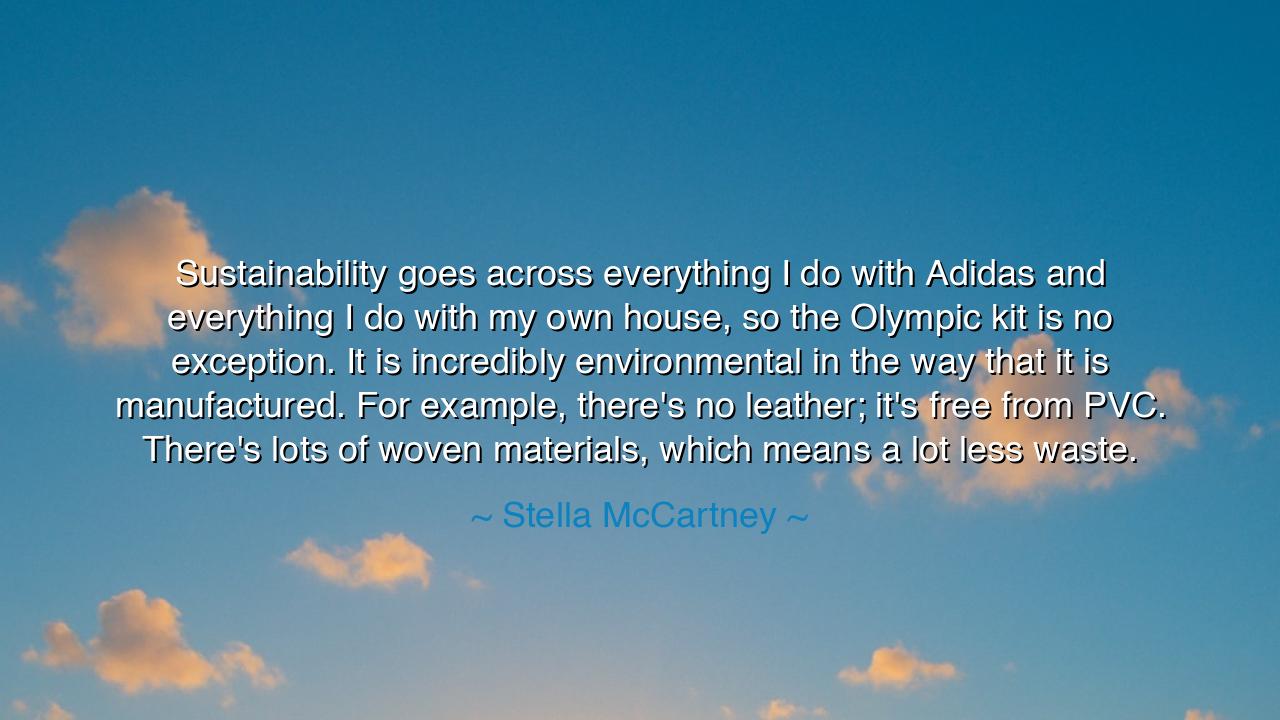
Sustainability goes across everything I do with Adidas and
Sustainability goes across everything I do with Adidas and everything I do with my own house, so the Olympic kit is no exception. It is incredibly environmental in the way that it is manufactured. For example, there's no leather; it's free from PVC. There's lots of woven materials, which means a lot less waste.






The words of Stella McCartney—“Sustainability goes across everything I do with Adidas and everything I do with my own house, so the Olympic kit is no exception. It is incredibly environmental in the way that it is manufactured. For example, there's no leather; it's free from PVC. There's lots of woven materials, which means a lot less waste.”—are more than a designer’s statement; they are the creed of a soul who understands that beauty and responsibility must walk hand in hand. In her voice, there is both artistry and conscience. She speaks not of fashion as adornment, but as ethics woven into fabric—a declaration that the elegance of creation must never come at the cost of the living world. Hers is the wisdom of one who has seen the ruin wrought by waste and seeks to mend it, stitch by mindful stitch.
The origin of this quote lies in McCartney’s work designing the Olympic uniforms for Team Great Britain, a project that united sport, art, and environmental philosophy. As the daughter of musician Paul McCartney and photographer Linda McCartney—both advocates of compassion and vegetarianism—Stella inherited a legacy of conscience. From the beginning of her career, she rejected the cruelty of leather and fur, choosing instead to build a brand that honors both style and sustainability. When she partnered with Adidas, her goal was not merely performance or prestige, but reformation—to prove that innovation could coexist with ethics, that progress need not destroy. The Olympic kit she describes became a living symbol of this creed: a triumph not only of design, but of moral vision.
To the ancients, craftsmanship was sacred work. The Greeks revered Hephaestus, god of the forge, not only for his skill, but for his devotion to creation that served harmony rather than harm. In this same spirit, McCartney’s approach transforms fashion into stewardship. Her decision to remove leather and PVC—materials long associated with environmental degradation—reflects a profound understanding that every act of creation carries consequence. She chooses woven materials, not for novelty, but for wisdom: woven fibers waste less, honor resources, and embody unity. What she crafts is not just clothing, but a philosophy—an affirmation that sustainability is not an accessory to greatness, but its foundation.
Her words also reflect a rebuke to the age of disposable culture. For centuries, humanity has clothed itself in the fruits of the earth, yet in the modern age, abundance has turned to exploitation. The fields, the waters, and the creatures have paid the price for our vanity. Yet McCartney stands as one who refuses this inheritance. Like a modern Athena, she seeks to teach that intelligence must guide creativity, that fashion can be both ethical and enduring. Her Olympic designs were not merely garments—they were a sermon in fabric, a reminder that even in the arena of glory and competition, the planet must not be forgotten.
We have seen this truth before in history. When William Morris, the 19th-century craftsman and poet, witnessed the soulless production of the Industrial Revolution, he cried out for a return to integrity in art. He urged that beauty must be made with care, and that the worker’s hand must honor the material it touches. Stella McCartney continues this lineage. Her sustainability is not a modern fad—it is the ancient reverence for craft reborn in a time that has forgotten it. She teaches that the artist’s duty is not only to please the eye, but to protect the world from which the art emerges.
In her statement, one feels the rhythm of balance—between innovation and restraint, between ambition and humility. The Olympic kit, worn by athletes who embody strength and endurance, becomes a metaphor for humanity’s relationship with nature. Just as athletes train the body to achieve harmony between power and precision, so must designers and citizens train the will to balance desire with duty. McCartney’s philosophy invites us all to think of every object, every purchase, as part of the greater weave of existence. For when one thread is wasted, the entire tapestry of the world is weakened.
The lesson, then, is both simple and eternal: let creation serve life. Whether we are artists, builders, or consumers, we hold in our hands the power to shape the world with wisdom or destroy it with carelessness. Let our choices reflect reverence. Let us design, build, and live as if the earth itself were our collaborator. For sustainability, as McCartney shows, is not a trend—it is the language of survival, the art of living beautifully without leaving scars.
Thus, remember these words, passed down like a thread from the loom of the wise: fashion, art, and innovation are not separate from morality. When we create with respect, we honor the past and safeguard the future. In every woven fiber, in every mindful act, we affirm what Stella McCartney’s life declares—that true beauty is harmony, and that the highest design is not the garment we wear, but the world we preserve.






AAdministratorAdministrator
Welcome, honored guests. Please leave a comment, we will respond soon